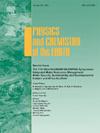冰川环境中高海拔地区微塑料来源和途径的系统综述
IF 3
3区 地球科学
Q2 GEOSCIENCES, MULTIDISCIPLINARY
引用次数: 0
摘要
在冰冻圈生态系统的各个部分都检测到微塑料,包括雪、冰雹、海冰、冰川和永久冻土。这种广泛存在突出了在这些敏感环境中了解其来源和途径的必要性。因此,本文利用文献计量学方法和PRISMA框架的可视化分析,综述了冰川环境中微塑料的来源、迁移和现状。该研究表明,微塑料的全球大气运输在污染冰川环境中起着至关重要的作用。此外,本综述的研究结果表明,高山生态系统中微塑料的存在可能归因于大气降水的沉积。文献计量分析的结果表明,关于冰川环境中微塑料的发表论文数量呈指数级增长,其中美国、英国和中国是主要的研究国家。来自中国和英国的出版物数量约占前10个国家所有出版物的一半(50%)。张勇、康生、王旭是冰川环境微塑性研究领域具有重要影响的作者。此外,文献计量学分析显示,在整个研究期间,与可持续发展目标(sdg)有关的微塑料和冰川的文献比例有所增加。这一观察结果表明,现有文献对与清洁水和卫生设施(可持续发展目标6)和气候行动(可持续发展目标13)相关的可持续发展目标(SDG)做出了重大贡献。本文章由计算机程序翻译,如有差异,请以英文原文为准。
A systematic review of sources and pathways of microplastics at higher altitudes in glaciated environments
Microplastics have been detected in various parts of cryosphere ecosystems, including snow, hail, sea ice, glaciers, and permafrost. This widespread presence highlights the need to understand their sources and pathways in these sensitive environments. Therefore, this review summarizes the sources and transport of microplastics and the current state of microplastics in the glaciated environment, utilizing the bibliometric method and visual analysis using the PRISMA framework. The study revealed that the global atmospheric transport of microplastics plays a crucial role in contaminating glaciated environments. Additionally, the findings of this review suggest that the presence of microplastics in high-mountain ecosystems may be attributed to deposition via atmospheric precipitation. The findings of the bibliometric analysis suggest that the number of published papers on microplastics in the glaciated environment has grown exponentially, with the USA, UK, and China being the leading research countries. The number of publications produced from China and the United Kingdom accounts for about half (50 %) of all publications from the top 10 countries. Zhang Y, Kang S, and Wang X were highly influential authors in microplastic research in glaciated environments. Additionally, a bibliometric analysis revealed that the percentage of literature addressing microplastics and glaciers in relation to the Sustainable Development Goals (SDGs) increased throughout the study period. The observation suggests that the existing body of literature makes a significant contribution to the Sustainable Development Goals (SDGs) related to clean water and sanitation (SDG 6) and Climate Action (SDG 13).
求助全文
通过发布文献求助,成功后即可免费获取论文全文。
去求助
来源期刊

Physics and Chemistry of the Earth
地学-地球科学综合
CiteScore
5.40
自引率
2.70%
发文量
176
审稿时长
31.6 weeks
期刊介绍:
Physics and Chemistry of the Earth is an international interdisciplinary journal for the rapid publication of collections of refereed communications in separate thematic issues, either stemming from scientific meetings, or, especially compiled for the occasion. There is no restriction on the length of articles published in the journal. Physics and Chemistry of the Earth incorporates the separate Parts A, B and C which existed until the end of 2001.
Please note: the Editors are unable to consider submissions that are not invited or linked to a thematic issue. Please do not submit unsolicited papers.
The journal covers the following subject areas:
-Solid Earth and Geodesy:
(geology, geochemistry, tectonophysics, seismology, volcanology, palaeomagnetism and rock magnetism, electromagnetism and potential fields, marine and environmental geosciences as well as geodesy).
-Hydrology, Oceans and Atmosphere:
(hydrology and water resources research, engineering and management, oceanography and oceanic chemistry, shelf, sea, lake and river sciences, meteorology and atmospheric sciences incl. chemistry as well as climatology and glaciology).
-Solar-Terrestrial and Planetary Science:
(solar, heliospheric and solar-planetary sciences, geology, geophysics and atmospheric sciences of planets, satellites and small bodies as well as cosmochemistry and exobiology).
 求助内容:
求助内容: 应助结果提醒方式:
应助结果提醒方式:


